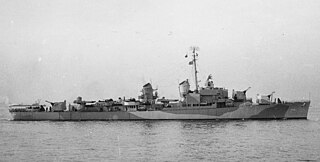
USS Stickell (DD-888) was a Gearing-class destroyer of the United States Navy. She was named for Lieutenant John H. Stickell USNR (1914–1943), who was killed in action at Jaluit Atoll in the Marshall Islands on 13 December 1943 and posthumously awarded the Navy Cross. She was renamed HS Kanaris (D212) on transfer to the Hellenic Navy in 1972.

USS Forrest Royal (DD-872) was a United States Navy Gearing-class destroyer constructed following the end of World War II. The ship saw service in the Korean War and the Vietnam War before being sold to Turkey in 1971. The ship was renamed TCG Adatepe and remained in service until being scrapped in 1993.

USS Hawkins (DD-873) was a Gearing-class destroyer in the United States Navy during World War II. Following the war, the ship saw service in the Korean War and in the 1970s, was transferred to the Republic of China Navy as Tze Yang. She remained in service until the 1990s. The ship was then scrapped with the exception of her superstructure, which became part of a display and training ground at the Zuoying Naval Academy.

USS Harwood (DD/DDE-861) was a Gearing-class destroyer of the United States Navy, in service from 1945 to 1971. She was transferred to Turkey in 17 December 1971 and sunk in error by Turkish aircraft on 21 July 1974.

USS Cone (DD-866) was a Gearing-class destroyer of the United States Navy, named for Rear Admiral Hutch Ingham Cone USN (1871–1941). She was laid down by the Bethlehem Steel Corporation at Staten Island, New York, on 30 November 1944, launched on 10 May 1945 by Mrs. H. I. Cone, and commissioned on 18 August 1945.

USS Joseph P. Kennedy Jr. (DD-850) is a former United States Navy Gearing-class destroyer. The ship was named after Lieutenant Joseph P. Kennedy Jr., a naval aviator, son of the former Ambassador to Britain, Joseph P. Kennedy Sr., and older brother of future President John F. Kennedy. Joseph P. Kennedy Jr. served, with interruptions for modernization, until 1973. Among the highlights of her service are the blockade of Cuba during the Cuban Missile Crisis and the afloat recovery teams for Gemini 6 and Gemini 7. Joseph P. Kennedy Jr. is on display as a museum ship in Battleship Cove, Fall River, Massachusetts. She was added to the National Register of Historic Places in 1976, and designated a National Historic Landmark in 1989 as one of a small number of surviving Gearing-class destroyers.

USS Hale (DD-642), a Fletcher-class destroyer, was the second ship of the United States Navy to be named for Maine Senator Eugene Hale (1836–1918).

USS Ingraham (DD-694) was a United States Navy Allen M. Sumner-class destroyer, the third ship in U.S. Navy history to be named for Duncan Ingraham. She was in commission from 1944 to 1971. Following her US service, she was sold to the Hellenic Navy and renamed Miaoulis. The ship was sunk as a target in 2001.

USS Charles H. Roan (DD-853) was a Gearing-class destroyer of the United States Navy. The ship was named after Charles Howard Roan, a United States Marine who lost his life in action on the island of Palau during World War II.

USS John R. Pierce (DD-753), an Allen M. Sumner-class destroyer, is the only ship of the United States Navy to be named for Lieutenant Commander John Reeves Pierce.

USS Henley (DD-762), an Allen M. Sumner-class destroyer, was the fourth ship of the United States Navy to be named Henley, was named after Captain Robert Henley ; an officer in the United States Navy during the Quasi-War with France, the War of 1812 and the Second Barbary War.

USS William R. Rush (DD/DDR-714) was a Gearing-class destroyer in the United States Navy during the Korean War. She was named for William R. Rush.

USS Charles J. Badger (DD-657) was a Fletcher-class destroyer of the United States Navy, named for Rear Admiral Charles J. Badger (1853–1932), whose service included the Spanish–American War and World War I.

USS Lewis Hancock (DD-675) was a Fletcher-class destroyer of the United States Navy.

USS McNair (DD-679) was a Fletcher-class destroyer of the United States Navy.

USS Norris (DD-859) was one of 98 Gearing-class destroyers in the United States Navy during the end of World War II. Norris was active from 9 June 1945 to 4 December 1970. Although built too late to see action during the war, the ship served in the Pacific, Atlantic, Asiatic, and Mediterranean areas.

The third USS Keppler (DD/DDE-765) was a Gearing-class destroyer in the United States Navy during the Korean War and the Vietnam War. She was named for Boatswain's Mate First Class Reinhardt J. Keppler (1918–1942), who was posthumously awarded the Medal of Honor for "extraordinary heroism" during the Naval Battle of Guadalcanal.

USS Holder (DD/DDE-819) was a Gearing-class destroyer of the United States Navy, the second Navy ship named for Lieutenant (jg) Randolph Mitchell Holder, a Navy pilot who was killed during the Battle of Midway.

The third USS Lloyd Thomas (DD/DDE-764) was a Gearing-class destroyer in the United States Navy during the Korean War and the Vietnam War.

USS Fiske (DD/DDR-842) was a Gearing-class destroyer of the United States Navy, the second Navy ship named for Rear Admiral Bradley A. Fiske (1854–1942), inventor of the Stadimeter and the aerial torpedo.





















